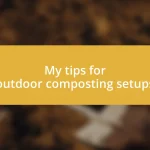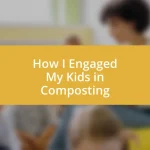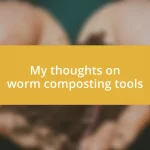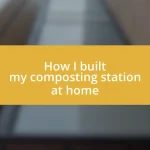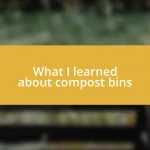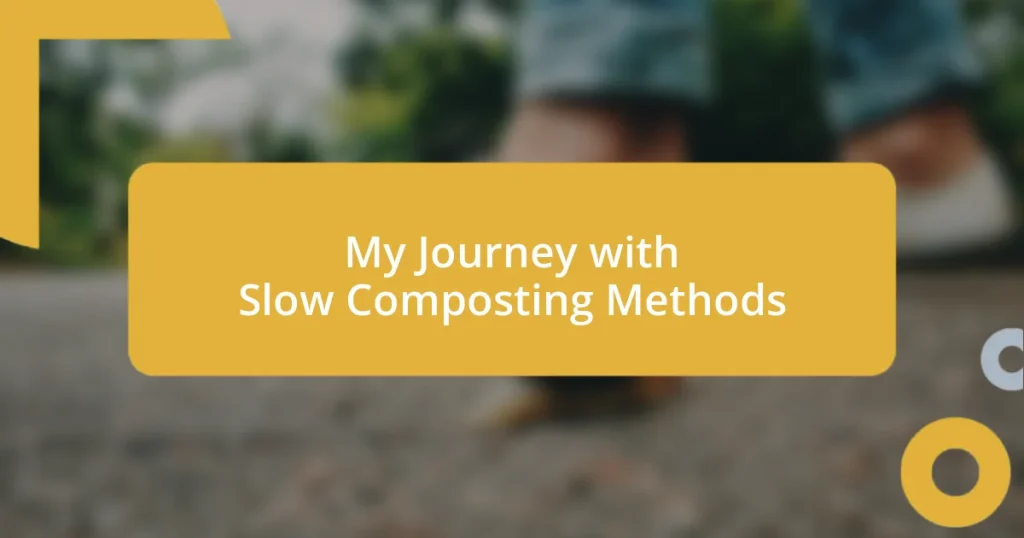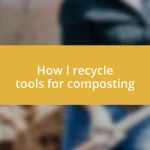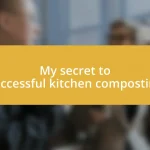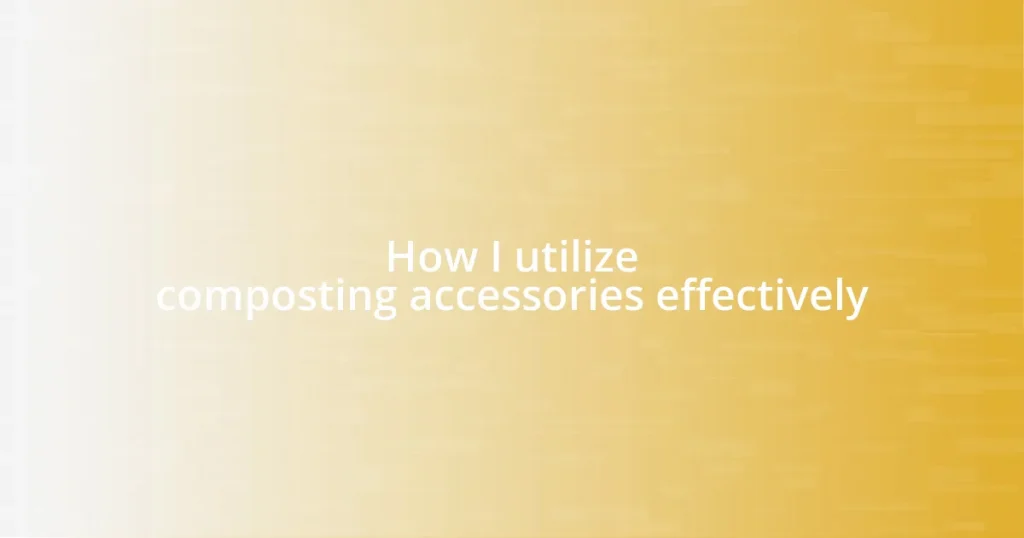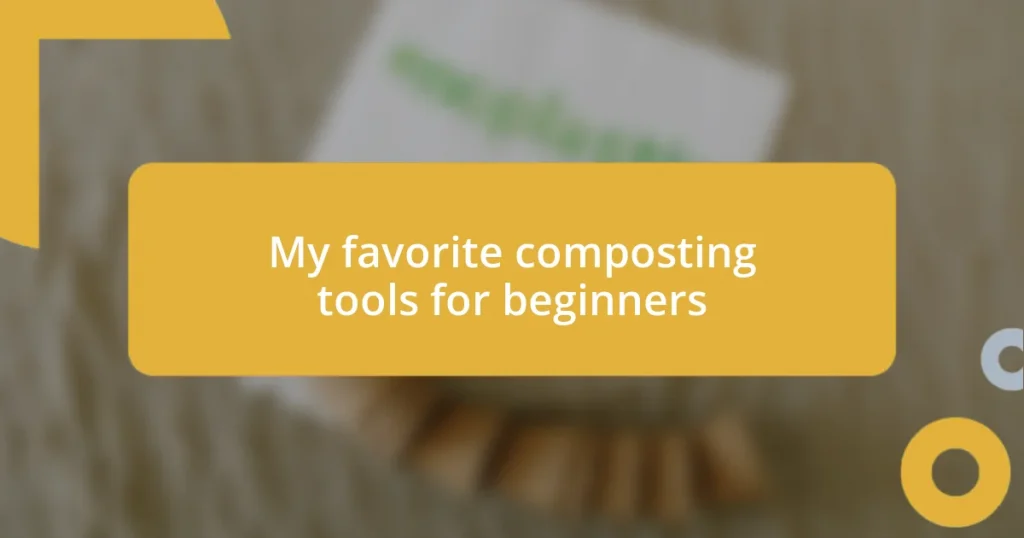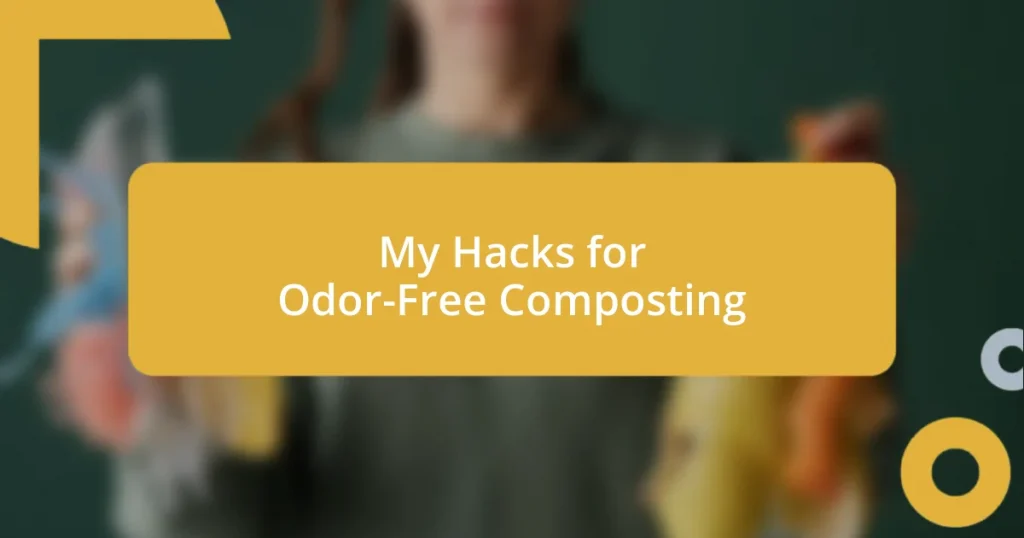Key takeaways:
- Slow composting is a nurturing process that transforms kitchen scraps into nutrient-rich soil, fostering biodiversity and a connection to nature.
- Key benefits of slow composting include creating high-quality compost, promoting sustainability by reducing landfill waste, and deepening appreciation for natural processes.
- Effective slow composting involves balancing greens and browns, managing moisture, and regularly turning the pile to enhance decomposition efficiency.

Understanding Slow Composting Methods
Slow composting methods are all about patience and nurturing. When I first started composting, I often felt like I was watching paint dry, waiting for the right conditions for decomposition to kick in. But there’s something so rewarding about seeing your kitchen scraps slowly transform into rich, dark soil. Have you ever taken the time to dig into a well-aged compost pile and truly appreciate that earthy aroma? It’s magical.
The beauty of slow composting lies in its simplicity. I remember starting my first pile with just yard waste and vegetable scraps, often marveling at how nature takes its time to work in harmony. You create layers, allowing air and moisture to work their magic—much like a recipe. It’s almost a meditative process, inviting you to engage with the very essence of decay and renewal.
Another aspect I found fascinating was how slow composting encourages biodiversity. The critters I discovered in my compost heap, from earthworms to diverse microbial life, felt like tiny inhabitants in an ecosystem I created. It made me realize that this nurturing process isn’t just about waste management—it’s about cultivating life. Have you ever noticed the difference in your garden’s vibrancy when using compost instead of chemicals? It’s like unlocking a secret formula for healthy plants!

Benefits of Slow Composting
Slow composting offers an array of benefits that extend beyond just waste reduction. I vividly remember the first time I used compost from my slow composting efforts in my garden; the plants thrived like never before! The nutrient-rich soil nourished them in ways synthetic fertilizers simply couldn’t. It’s a reminder of how organic matter can breathe life into our growing space.
Another advantage is its sustainability. By opting for slow composting, I felt a profound sense of connection to the environment. I was reducing landfill waste and minimizing my carbon footprint, all while embracing a slower, more mindful way of living. Isn’t it satisfying to know that each layer you add to your compost pile contributes to a healthier planet?
Moreover, slow composting fosters a deeper understanding of nature’s processes. Each time I turned my compost pile, I witnessed nature at work—how decomposition leads to renewal. This experience sparked an appreciation for the cycle of life. Have you ever noticed how enriching it feels to nurture something from scraps to soil? It’s like watching a small miracle unfold right in your backyard.
| Benefit | Description |
|---|---|
| Nutrient-rich Soil | Slow composting creates high-quality compost that enhances plant growth and health. |
| Sustainability | It significantly reduces waste sent to landfills, promoting eco-friendly practices. |
| Connection to Nature | Offers insight into natural processes, fostering a sense of appreciation for the environment. |

How to Start Slow Composting
To embark on your journey with slow composting, select a dedicated spot in your yard or garden. It could be as simple as a corner where you can add materials over time without it feeling like an eyesore. I remember setting up my first compost area and feeling a sense of purpose as I layered grass clippings, vegetable scraps, and leaves. It felt like creating a home for my leftovers, nurturing them as they decomposed into something beautiful.
Here’s how to get started:
– Choose the Right Location: Pick a well-drained area that’s convenient.
– Gather Materials: Collect a balance of greens (nitrogen-rich) and browns (carbon-rich) like vegetable scraps, leaves, and shredded paper.
– Create Layers: Start with a layer of coarse items (like twigs) to allow airflow, followed by alternating layers of greens and browns.
– Maintain Moisture: Water the pile if it’s too dry, aiming for a sponge-like consistency.
– Turn It Occasionally: Gently mixing the compost every few weeks helps aerate and speed up decomposition.
The experience can be wonderfully intimate; I recall the first time I turned my compost and unearthed the thriving life within. It was like peeling back the layers of an onion to reveal a hidden treasure, full of worms and microbial life, all working in unison. In that moment, I could feel the pulse of nature—how every small action I took contributed to a larger, beautiful cycle. You’ll find joy in the transformation, like watching a caterpillar become a butterfly; it’s a connection to the earth that’s truly unparalleled.

Ideal Materials for Slow Composting
When it comes to selecting materials for slow composting, balance is key. I’ve learned through trial and error that mixing green materials—like grass clippings and vegetable scraps—with brown materials, such as dry leaves and shredded newspapers, creates a rich environment for beneficial microorganisms. I recall a time when I only used kitchen scraps, and my compost pile just didn’t thrive. It took a while for me to realize that adding carbon-rich materials was essential for a successful composting process.
In my experience, dampness is equally crucial. I’ve found that materials with high moisture content, like fresh fruit peels, can introduce excess moisture, leading to a soggy mess. A memorable mishap involved a batch of watermelon rinds that turned my compost into a swamp! Now, I always ensure that there’s a good mix of dry and wet materials, which strikes the right balance for aeration and decomposition. It’s a fascinating dance between moisture and air, isn’t it?
Finally, I’ve discovered that avoiding certain items can save a lot of headaches. Materials like dairy, meat, and oily foods can attract unwanted pests and create odors that are less than pleasant. One morning, after adding leftover pizza to my pile, I woke up to find my backyard buzzing with flies! Now, I’m more mindful of what I add, opting for organic or plant-based scraps only. By carefully curating my compost materials, I’ve created a thriving ecosystem that benefits not just my garden, but also deepens my connection to the cycle of life around me.

Troubleshooting Slow Composting Issues
One common issue I’ve encountered with slow composting is a lack of decomposition over time. I remember checking my pile one summer, expecting to see rich, dark compost, only to find a mountain of barely recognizable scraps. It was frustrating! I quickly realized that I hadn’t mixed my greens and browns well enough, which limited airflow. Now, I always take the time to shred larger materials and ensure I’m creating that all-important balance. Have you ever experienced something similar?
Another predicament I’ve faced is excess moisture, which can create foul odors and attract unwanted critters. I vividly recall the time I left some wet coffee grounds too long in my compost; the smell was a wake-up call that I couldn’t ignore! Since then, I’ve learned to monitor moisture levels, adding dry materials to combat dampness. A simple tip I now follow is using a pitchfork to aerate the compost regularly. It not only helps with moisture control but also reinvigorates the decomposition process.
Lastly, I’ve learned the hard way that certain weeds can halt progress in your compost pile. It happened to me when I tossed in some seemingly harmless garden trimmings, only to find that persistent weeds sprouted everywhere I spread the finished compost. Now, I’m cautious, taking care to avoid seeds from invasive plants and ensuring that everything I add has been adequately decomposed. Have you found yourself in a similar situation, wondering how those pesky seedlings appeared? By staying aware of what goes into my compost, I’ve managed to cultivate a more successful and enriching experience, both for my pile and my garden.

Maximizing Efficiency in Slow Composting
Maximizing efficiency in slow composting often starts with the right size of your compost pile. I recall my early days where I thought bigger was better, only to end up with a heap that never fully broke down. Finding the sweet spot—around three feet high—allows heat and microorganisms to thrive. Have you ever thought about the ideal size for your compost? It’s fascinating how a little adjustment can make such a noticeable difference.
Another strategy I’ve adopted is layering my materials thoughtfully. By creating layers of greens and browns, I realize that I can encourage better airflow throughout the pile. It’s almost like building a sandwich! I remember a time when I dumped everything in randomly, and the pile became compacted, stifling its ability to decompose. Now, I make a conscious effort to alternate my layers, and the results speak for themselves. Isn’t it satisfying to see how these small tweaks can promote a healthier compost?
Lastly, regularly turning the compost has become a ritual for me, rather than a chore. There’s something almost meditative about it. When I discovered that turning the pile speeds up the decomposition process significantly, it felt like a light bulb moment. I often think back to those early weeks when I neglected this step and was left with little more than unrecognizable scraps. Creating that airflow not only revitalizes the compost but also connects me more with the natural transformation happening within it. Have you established similar routines in your own composting journey?

Using Finished Compost Effectively
When it comes to using finished compost effectively, I’ve truly learned the importance of knowing how much to apply. I vividly remember the first time I generously spread compost over my garden without considering the depth—it was a thick layer that nearly smothered my seedlings! Now, I always aim for a thin, even layer, about one to two inches thick, which offers plenty of nutrients without overwhelming my plants. Have you ever poured on too much, only to find your plants struggling? Knowing the “just right” amount makes all the difference.
In my experience, incorporating finished compost into potting soils is a game changer. I recall potting up some herbs with store-bought mix and then sprinkling in my homemade compost. The difference was remarkable! The plants thrived, growing lush and vibrant, which made me feel accomplished and proud. By mixing about one part compost to three parts soil, I found a balance that works beautifully. Have you tried this method in your pots? Believe me, it’s worth it!
I also explore using finished compost as a top dressing for my lawn. I can’t help but smile as I watch my grass flourish after I’ve given it that nutrient boost. The first time I tried this, I was skeptical. Would it really make a difference? To my delight, the color deepened, and my lawn felt softer underfoot. Now, it’s a regular part of my lawn care routine, and seeing the transformation reminds me of nature’s incredible ability to regenerate. Have you seen this kind of impact in your own yard? It’s moments like these that deepen my connection to gardening.



